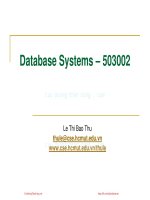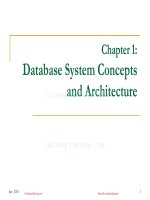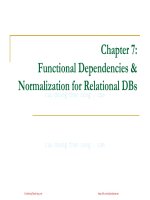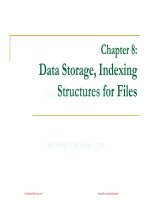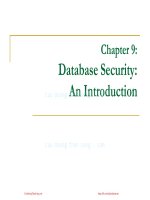cơ sở dữ liệu lê thị bảo thu chương ter c6 recovery sinhvienzone com
Bạn đang xem bản rút gọn của tài liệu. Xem và tải ngay bản đầy đủ của tài liệu tại đây (671.39 KB, 39 trang )
Chapter 6
Database Recovery Techniques
Adapted from the slides of “Fundamentals of Database Systems”
(Elmasri et al., 2006)
CuuDuongThanCong.com
/>
1
Outline
Purpose of Database Recovery
Recovery Concepts
Recovery Based on Deferred Update
Recovery Based on Immediate Update
Shadow paging
ARIES Recovery Algorithm
Recovery in Multidatabase System
CuuDuongThanCong.com
/>
2
1. Purpose of Database Recovery
To bring the database into the last consistent state,
which existed prior to the failure.
To preserve transaction properties (Atomicity,
Consistency, Isolation and Durability).
Example:
If the system crashes before a fund transfer
transaction completes its execution, then either one or
both accounts may have incorrect value.
Thus, the database must be restored to the state
before the transaction modified any of the accounts.
CuuDuongThanCong.com
/>
2. Recovery Concepts (1)
Types of Failure
The database may become unavailable for use
due to
Transaction failure: Transactions may fail because
of incorrect input, deadlock, incorrect synchronization.
System failure: System may fail because of
addressing error, application error, operating system
fault, RAM failure, etc.
Media failure: Disk head crash, power disruption, etc.
CuuDuongThanCong.com
/>
Recovery Concepts (2)
Transaction Log
For recovery from any type of failure data values prior to
modification (BFIM - BeFore Image) and the new value after
modification (AFIM – AFter Image) are required.
These values and other information is stored in a sequential
file called Transaction log. A sample log is given below. Back
P and Next P point to the previous and next log records of the
same transaction.
T ID Back P Next P Operation Data item
Begin
T1
0
1
T1
1
4
Write
X
Begin
T2
0
8
T1
2
5
W
Y
T1
4
7
R
M
T3
0
9
R
N
T1
5
nil
End
CuuDuongThanCong.com
BFIM
AFIM
X = 100
X = 200
Y = 50 Y = 100
M = 200 M = 200
N = 400 N = 400
/>
Recovery Concepts (3)
Data Caching
Data items to be modified are first stored into
database cache by the Cache Manager (CM)
and after modification they are flushed (written)
to the disk.
The flushing is controlled by Modified and PinUnpin bits.
Pin-Unpin: Instructs the operating system not to flush
the data item.
Modified: Indicates the AFIM of the data item.
CuuDuongThanCong.com
/>
Recovery Concepts (4)
Data Update:
Immediate Update: As soon as a data item is modified in
cache, the disk copy is updated.
Deferred Update: All modified data items in the cache is
written either after a transaction ends its execution or after a
fixed number of transactions have completed their execution.
Shadow update: The modified version of a data item does
not overwrite its disk copy but is written at a separate disk
location.
In-place update: The disk version of the data item is
overwritten by the cache version.
CuuDuongThanCong.com
/>
Recovery Concepts (5)
Transaction Roll-back (Undo) and Roll-Forward
(Redo)
To maintain atomicity, a transaction’s operations are
redone or undone.
Undo: Restore all BFIMs on to disk (Remove all AFIMs).
Redo: Restore all AFIMs on to disk.
Database recovery is achieved either by performing only
Undo or only Redo or by a combination of the two.
These operations are recorded in the log as they
happen.
CuuDuongThanCong.com
/>
Recovery Concepts (6)
Write-Ahead Logging
When in-place update (immediate or deferred) is used
then log is necessary for recovery and it must be
available to recovery manager. This is achieved by
Write-Ahead Logging (WAL) protocol. WAL states that:
For Undo: Before a data item’s AFIM is flushed to the
database disk (overwriting the BFIM) its BFIM must be
written to the log and the log must be saved on a stable
store (log disk).
For Redo: Before a transaction executes its commit
operation, all its AFIMs must be written to the log and the
log must be saved on a stable store.
CuuDuongThanCong.com
/>
Recovery Concepts (7)
Steal/No-Steal and Force/No-Force
Possible ways for flushing database cache to
database disk:
1.
2.
1.
2.
Steal/No-Steal:
Steal: Cache can be flushed before transaction
commits.
No-Steal: Cache cannot be flushed before
transaction commit.
Force/No-Force:
Force: Cache is immediately flushed (forced) to
disk before the transaction commit.
No-Force: Otherwise.
CuuDuongThanCong.com
/>
Recovery Concepts (8)
Steal/No-Steal and Force/No-Force
These give rise to four different ways for
handling recovery:
Steal/No-Force (Undo/Redo)
Steal/Force (Undo/No-redo)
No-Steal/No-Force (Redo/No-undo)
No-Steal/Force (No-undo/No-redo)
CuuDuongThanCong.com
/>
11
Recovery Concepts (9)
Checkpointing
Time to time (randomly or under some criteria) the
database flushes its buffer to database disk to
minimize the task of recovery. The following steps
defines a checkpoint operation:
1.
2.
3.
4.
Suspend execution of transactions temporarily.
Force write modified buffer data to disk.
Write a [checkpoint] record to the log, save the log to disk.
Resume normal transaction execution.
During recovery redo or undo is required to
transactions appearing after [checkpoint] record.
CuuDuongThanCong.com
/>
Recovery Concepts (10)
Fuzzy Checkpointing
The time need to force-write all modified memory
buffers may delay transaction processing
Fuzzy checkpointing.
System can resume transaction processing after a
[begin_checkpoint] record is written to the log without
having to wait for step 2 to finish.
When step 2 is completed [end_checkpoint] record is
written to the log.
Until step 2 is commpleted, the previous checkpoint
record should maintain valid.
CuuDuongThanCong.com
/>
3. Recovery Based on Deferred
Update (1)
Deferred Update (No Undo/Redo)
The data update goes as follows:
A set of transactions records their updates in the
log.
At commit point under WAL scheme these
updates are saved on database disk.
After reboot from a failure the log is used to redo
all the transactions affected by this failure. No
undo is required because no AFIM is flushed to
the disk before a transaction commits.
CuuDuongThanCong.com
/>
Recovery Based on Deferred Update (2)
Deferred Update in a single-user system
There is no concurrent data sharing in a single user
system. The data update goes as follows:
A set of transactions records their updates in the log.
At commit point under WAL scheme these updates are
saved on database disk.
After reboot from a failure the log is used to redo all the
transactions affected by this failure. No undo is required
because no AFIM is flushed to the disk before a
transaction commits.
CuuDuongThanCong.com
/>
T1
read_item (A)
read_item (D)
write_item (D)
--- log --[start_transaction, T1]
[write_item, T1, D, 20]
[commit T1]
[start_transaction, T2]
[write_item, T2, B, 10]
[write_item, T2, D, 25]
T2
read_item (B)
write_item (B)
read_item (D)
write_item (D)
system crash
Redo [write_item, T1, D, 20] of T1
Ignore T2
CuuDuongThanCong.com
/>
Recovery Based on Deferred Update (3)
Deferred Update with concurrent users
This environment requires some concurrency control mechanism
to guarantee isolation property of transactions. In a system
recovery transactions which were recorded in the log after the
last checkpoint were redone. The recovery manager may scan
some of the transactions recorded before the checkpoint to get
the AFIMs.
CuuDuongThanCong.com
/>
CuuDuongThanCong.com
/>
Recovery Based on Deferred Update (4)
Deferred Update with concurrent users
Two tables are required for implementing this protocol:
Active table: All active transactions are entered in this
table.
Commit table: Transactions to be committed are entered
in this table.
During recovery, all transactions of the commit table are
redone and all transactions of active tables are ignored
since none of their AFIMs reached the database. It is
possible that a commit table transaction may be redone
twice but this does not create any inconsistency because
of a redone is “idempotent”, that is, one redone for an
AFIM is equivalent to multiple redone for the same AFIM.
CuuDuongThanCong.com
/>
--- log --[start_transaction, T1]
• Ignore: T2 & T3
[write_item, T1, D, 20]
• Redo: T1 & T4
[checkpoint]
[start_transaction, T4]
[write_item, T4, B, 15]
[start_transaction T2]
[commit, T1]
[write_item, T4, A, 20]
[commit, T4]
[write_item, T2, B, 12]
[start_transaction, T3]
[write_item, T3, A, 30]
[write_item, T2, D, 25] system crash
D 20
B 15
A 20
CuuDuongThanCong.com
/>
4. Recovery Based on Immediate
Update (1)
Undo/No-redo Algorithm
In this algorithm AFIMs of a transaction are
flushed to the database disk under WAL before it
commits.
For this reason the recovery manager undoes all
transactions during recovery.
No transaction is redone.
It is possible that a transaction might have
completed execution and ready to commit but this
transaction is also undone.
CuuDuongThanCong.com
/>
Recovery Based on Immediate
Update (2)
Undo/Redo Algorithm (Single-user
environment)
Recovery schemes of this category apply undo and
also redo for recovery.
In a single-user environment no concurrency control is
required but a log is maintained under WAL.
Note that at any time there will be one transaction in
the system and it will be either in the commit table or
in the active table.
The recovery manager performs:
Undo of a transaction if it is in the active table.
Redo of a transaction if it is in the commit table.
CuuDuongThanCong.com
/>
Recovery Based on Immediate
Update (3)
Undo/Redo Algorithm (Concurrent execution)
Recovery schemes of this category applies undo and
also redo to recover the database from failure.
In concurrent execution environment a concurrency
control is required and log is maintained under WAL.
Commit table records transactions to be committed and
active table records active transactions. To minimize the
work of the recovery manager checkpointing is used.
The recovery performs:
Undo of a transaction if it is in the active table.
Redo of a transaction if it is in the commit table.
CuuDuongThanCong.com
/>
--- log --[start_transaction, T1]
[write_item, T1, D, 12, 20]
[checkpoint]
[start_transaction, T4]
[write_item, T4, B, 23, 15]
[start_transaction T2]
[commit, T1]
[write_item, T2, B, 15, 12]
[start_transaction, T3]
[write_item, T4, A, 30, 20]
[commit, T4]
[write_item, T3, A, 20, 30]
[write_item, T2, D, 20, 25]
[write_item, T2, B, 12, 17]
system crash
CuuDuongThanCong.com
Undo: T2 & T3
B 12
D 20
A 20
B 15
Redo: T1 & T4
D 20
B 15
A 20
/>
5. Shadow paging (1)
The AFIM does not overwrite its BFIM but recorded at
another place on the disk. Thus, at any time a data item
has AFIM and BFIM (Shadow copy of the data item) at
two different places on the disk.
X
Y
X'
Y'
Database
X and Y: Shadow copies of data items
X' and Y': Current copies of data items
CuuDuongThanCong.com
/>
